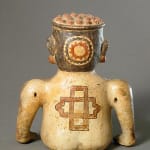Galo Polychrome Male Shaman Figure, 500 CE - 1000 CE
Terracotta
8
PF.3573
Further images
This male shaman figure comes from the Guanacaste-Nicoya polychrome tradition, the Galo polychrome style. Its mirror-bright burnished surfaces are technically unsurpassed by any Pre-Columbian pottery, and yellows, reds, oranges, creams,...
This male shaman figure comes from the Guanacaste-Nicoya polychrome tradition, the Galo polychrome style. Its mirror-bright burnished surfaces are technically unsurpassed by any Pre-Columbian pottery, and yellows, reds, oranges, creams, maroons, and blacks of the polychrome decorations are impressively vivid. Among such sculptures are the full human figures with elaborate representations of tattoos or body paint. Such brilliant polychrome tradition represent an important social dimension; when the northern trade network that brought jade, slate-backed pyrite mirrors, foreign ceramics, and other luxury goods, the Nicoyans responded by producing their own special purpose pottery. Inspired by northern models, it also incorporated local and southern elements, forming a dazzling hybrid style that was traded around Central America and southern Meso-America in the centuries to come. This unique male figure is a portrayal of a person born with a physical disorder that restricts the use of his legs. His strong arms and hands that support his upper body help him to travel, and extremely small legs are depicted to indicate the physical limitation. This figure, however, is elaborately decorated with complex patterns and colors. Wearing a headdress and earspools, his shoulders and cheeks are enhanced with sun disk like shapes and his eyes are painted black. The mouth is open to reveal teeth in detail. In Ancient Meso-America, people born with physical disorder, such as hunchbacks, were considered to possess special powers and were chosen as shamans. They played a crucial role in rituals and ceremonies, executing magical performances. A fine example of Galo polychrome figures, the figure provides a wealth of ethnographic detail.





